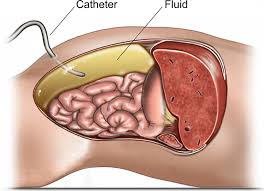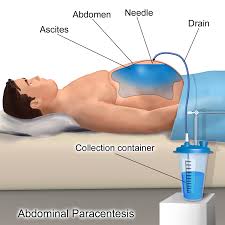
 Performed in patients with suspected bacterial peritonitis, in patients with ascites of unknown cause, to relieve symptoms of shortness of breath and or abdominal discomfort when significant ascites is present.
Performed in patients with suspected bacterial peritonitis, in patients with ascites of unknown cause, to relieve symptoms of shortness of breath and or abdominal discomfort when significant ascites is present.
Complications include bleeding, fluid leak, bowel or bladder perforation and the introduction of infection.
Should be avoided in the presence of DIC.
In the presence of small bowel obstruction a nasogastric tube should be place to reduce the risk of the procedure.
Can safely be performed despite the presence of coagulopathy or thrombocytopenia without administration of blood products.
Mandatory labs tests performed on ascitic fluid include a CBC with differential, measurement of protein, albumin, culture and Gram stain. Optional tests depending on the clinical suspicion include: amylase levels, cytology, LDH, glucose levels and AFB studies.
In patients with urinary retention, catherization of the bladder should take place prior to the procedure.
In patients with small amount of ascites, loculated fluid, or have large abdominal viscera or have extensive adhesions ultrasound guidance may be needed to perform the procedure.
Sites of the procedure include the left lower quadrant, suprapubic or right lower quadrant areas of the abdomen.
Should not be performed in areas of infection, inflammation, or hematomas.
Abdominal paracetensis with the removal of 50-100 cc is essential for establishing a differential diagnosis.
Paracentesis is a required procedure for patients with chronic ascites, ascites of unknown origin, sudden onset of ascites, suspected perforation of the gastrointestinal tract, and blunt trauma to the abdomen.
The two most common indications for ascites are complications of cirrhosiss and suspected intra-abdominal malignancy.
Laboratory assessment includes gross examination of the fluid for color and clarity, blood counts, differential leukocyte examination, analysis of total protein, amylase, LDH, microbial studies including Gram stain, routine cultures, anaerobic cultures, tuberculosis cultures, and cytologic examination.
